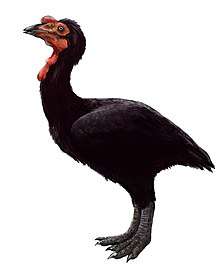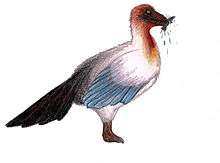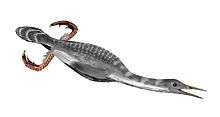Achillobator
Achillobator (/əˌkɪləˈbaɪtɔːr/ ə-KIL-ə-BAY-tor; meaning '"Achilles hero") is a genus of large dromaeosaurid theropod dinosaurs that lived in Asia during the Late Cretaceous period about 96 million to 89 million years ago in what is now the Bayan Shireh Formation. The first remains were found in 1989 during a mongolian-russian field expedition in Mongolia and later described in 1999. The genus is currently monotypic, only including the type species A. giganticus. Since the first discovery and description, no more specimens have been found. It represents the first and largest dromaeosaurid taxon known from the Bayan Shireh Formation.
| Achillobator | |
|---|---|
 | |
| Skeletal diagram showing the size and preserved elements from holotype MNUFR-15 | |
| Scientific classification | |
| Kingdom: | Animalia |
| Phylum: | Chordata |
| Clade: | Dinosauria |
| Clade: | Saurischia |
| Clade: | Theropoda |
| Family: | †Dromaeosauridae |
| Clade: | †Eudromaeosauria |
| Subfamily: | †Dromaeosaurinae |
| Genus: | †Achillobator Perle et al. 1999 |
| Type species | |
| †Achillobator giganticus Perle et al. 1999 | |
They were large, heavy-built, ground-dwelling, bipedal carnivores that would have been active feathered predators, hunting with the enlarged, sickle claw on each second toe. Achillobator are considered to be some of the largest dromaeoaurs, estimated to have cover 5 to 6 m (16 to 20 ft) in length and weighed 250 kg (550 lb). Along with Austroraptor, Dakotaraptor and Utahraptor, they are the largest known dromaeosaurs. The most characteristic feature of Achillobator is its primitive pelvis, having a vertically oriented pubis that differs from the rest of dromaeosaurids. Most of its preserved elements are very robust, an unusual trait in dromaeosaurs, which are generally more lightly built and smaller.
Achillobator is classified as a dromaeosaurid taxon, more specifically within the Eudromaeosauria, a group of hypercarnivore animals that were mainly terrestrial instead of arboreal or amphibious. In most cladistic analyses Achillobator is recovered as a close relative of Dromaeosaurus and Utahraptor, although it is often considered to be the sister taxon of the latter.
History of discovery
In 1989, during a field exploration conducted by the Mongolian and Russian Paleontological Expedition in the Gobi Desert, examining the outcrops at Khongil, South Central Mongolia, many dinosaur fossil discoveries were made. About 5.6 km away from the Khongil locality, a large and mostly disarticulated partial theropod skeleton was discovered in fine-grained, medium sandstone/gray mudstone that was deposited dating back to the Late Cretaceous epoch at the Burkhant locality, Bayan Shireh Formation. The preserved specimen was found in association with a left maxilla preserving nine teeth and two alveoli, four cervical vertebrae, three dorsal vertebrae and eight caudal vertebrae, a nearly complete pelvic girdle compromising both pubes, right illium and right ischium, both femora and left tibia, left metatarsals III and IV, manual and pedal phalanges with some unguals, right scapulocoracoid, an isolated radius, two ribs and caudal chevrons. Traces of tail tendons were found too, but mostly isolated. It was collected and exceptionally prepared by the assistant paleontologist Namsarai Batulseen and stored as MNUFR-15. Ten years later, the unusual specimen was formally described in 1999 and became the holotype for the new genus and species: Achillobator giganticus. It was identified as a dromaeosaurid taxon, a large one. The description was performed by the Mongolian paleontologist Altangerel Perle, and North American paleontologists Mark A. Norell and James M. Clark.[1]
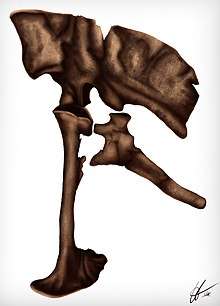
However, the description was published in a very preliminary format, being not complete at all, having a few issues with the preserved elements and numerous typographical errors. For instance, metatarsals II and III (of unknown position) were claimed as preserved elements, but in further pages there is no mention of them, a similar case may apply to the preserved left metatarsals III and IV, which at some point are attributed to the left pes, but afterwards to the right one.[1] The paper was likely published without the knowledge of the two latter paleontologists, as indicated by a draft left in Mongolia in 1997.[2] Due to a misinterpretation, the supposed pedal ungual II was claimed to be preserved and to articulate with the pedal phalanx II, however, this was corrected by Senter in 2007 and this ungual actually represents a manual one.[3] In terms of etymology, the generic name, Achillobator, is derived from the Latin word Achillis (genitive singular of Achilles) in reference to the large Achilles tendon that supported the second pedal ungual (known as "sickle" claw) of most dromaeosaurids, and the old Mongolian word баатар (baatar, meaning hero). The specific name, giganticus, is derived from the Ancient Greek word γιγαντικός (gigantikós, meaning gigantic) in reference to the large size of the holotype, which exceeds most dromaeosaurids.[1]
Chimera hypothesis
The pelvic girdle of Achillobator features plesiomorphic saurischian characteristics compared to other dromaeosaurids. For instance, the pubis is aligned vertically and has a relatively large pubic boot (a wide expansion at the end), unlike most other dromaeosaurids, where there is generally a much smaller boot. The preserved vertebrae are very robust and features a series of pleurocoels.[1] The above differences and led Burnham et al. 2000 to suggest that the holotype of Achillobator in fact, represents a paleontological chimera, arguing that only the pedal unguals may have come from a dromaeosaurid-grade dinosaur.[4] However, the specimen was actually found in semiarticulation and therefore the assignment of remains to a single individual is validated.[5][2] Although Achillobator features unusual and primitive characteristics compared to other relatives, the genus keeps being recovered as a dromaeosaur taxon.[6][7]
Description
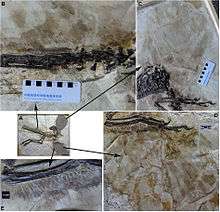

They were among the largest dromaeosaurs; the holotype and only known individual of Achillobator was originally estimated to be three times as big as Deinonychus.[1] Overall, they were massive and ponderous animals, estimated to have reach lengths from 5 to 6 m (16 to 20 ft) and weights ranging from 227 to 250 kg (500 to 551 lb).[8][9] Nevertheless, there are alternative body size estimates. During the description of Mahakala in 2007, Turner and colleagues used body mass equations to estimate weight and length in many paravians. Achillobator were estimated at 4.85 m (15.9 ft) long with weights of 347.9 kg (767 lb).[10] In 2008 Novas and colleagues gave a length of 4.45 m (14.6 ft) and a weight of 264 kg (582 lb).[11] In the large taxonomic revision of the Dromaeosauridae performed by Turner and colleagues in 2012, they estimated the weight under 300 kg (660 lb) and they noted that this genus represents the second largest dromaeosaurid taxon (after Utahraptor) with a tibial length of 49 cm (490 mm).[2]
Achillobator were deep-bodied and relatively short-armed animals with stocky and robust hindlimbs. Some of the most prominent features consisted in the strongly vertical pubis and the robustly built skeleton such as the deep maxilla and femur.[1] The holotype was found lacking traces of feather integument, however, there are strong evidence coming from other relatives that suggest the likely presence of plumage on Achillobator, such as the smaller and also Asian taxa Velociraptor[12] and Zhenyuanlong,[13] or the North American Dakotaraptor[14] and Dineobellator.[15] According to the revised diagnosis by Turner and colleagues in 2012, Achillobator can be distinguished based on the following combination of characteristics and autapomorphies: the promaxillary fenestra is completely exposed, the promaxillary and maxillary fenestrae are elongate and vertically oriented at same level in the maxilla, metatarsal III is wide on the upper end, the femur is longer than the tibia, the pelvis is propubic, the obturator process on the ischium is large and triangular situated on the upper half of ischial shaft, the boot at distal symphysis of pubis is developed in a cranial and caudal aspect.[2]
Crania
The preserved maxilla is partially complete, missing pretty much of its nasal processes. It measures 29.08 cm (290.8 mm) in length and the lateral side is smooth compared to the dorsal areas, although its structure is very robust. It preserves 11 alveoli, of which 9 are filled with well-preserved teeth. The teeth display marked homodonty (teeth of similar size) and they are serrated and recurved with the posterior serrations being slightly larger than the anterior serrations. Along with the posterior serrations, there are 15 or 18 denticles per 5 mm (0.50 cm) near the center of the teeth., although the anterior serrations have 17 to 20 denticles per 5 mm (0.50 cm). Given the dimensions of the preserved maxilla, Perle and colleagues suggested that Achillobator had a relatively large skulls, competing to those of Carnosaurs.[1]
Postcrania
Well preserved material is known from the axial area, compromising very robust and somewhat large cervical, dorsal and caudal vertebrae. There are about four cervicals preserved. As stated by the authors, the anterior series of cervical vertebrae are sharply-angled developed, with the anterior articulation facet of the centrum developed over the posterior facet. These characteristics are indicators of a S-shaped neck, as seen in most maniraptorans. Three dorsals were preserved with apparently two dorsal ribs. The dorsals are stocky and have pleurocoels at the lateral surfaces, some dorsals have two. Their centrum articulation facets are rounded and concave in shape. In general, the neural processes of the dorsal vertebrae show resemblance to those of large ratites such as the extinct moa and extant emu, ostrich and cassowary. They feature protruding interspinous ligaments scars that indicates a robust and similar back to those birds. Eight caudals were found with one of the caudals belonging to the transitional series (anteriormost), three to the middle area and four to the posterior end. These four were found in articulation. Some traces of tail tendons were found isolated, probably indicators of a riged tail. In all the caudal vertebrae the centrum is amphiplatian (flat on both ends) with the posterior articulation facet being more concave than the anterior one. As indicated by the transitional caudal, the anterior neural spines are elongated and progressively disappear on posterior caudals.[1]
Regarding the shoulder girdle, only the right scapulocoracoid and a radius were preserved, the latter was not described. However, the radius was measured at 26 cm (260 mm) long. In the posterior area of the acromion process, the scapula preserves a small tubercle that attached area for the muscle scapulohumeralis in life. The glenoid is located at the bottom area facing to the lateral side. The scapula is relatively elongated and flattened at the scapular blade. The blade is thickened and slightly curved to the inner side following the rounded shape of the rib cage. The coracoid is robust and broad, measuring 16.7 cm (167 mm) long and 14.8 cm (148 mm) in height. The anterior edge is coarsely textured, likely for the articulation with cartilaginous tissue. A large foramen is located from the front to the back, probably acting as a channel for blood vessels and nerves.[1]

Both femora were nicely preserved. In general terms, the femur is highly robust and longer than the tibia, a rare trait in dromaeosaurids, measuring 50.5 cm (505 mm) in length. It preserves detailed information of muscle attachments. On the anterior inner surface, there's a large, sculptured, concave surface that likely worked as the insertion for the m. iliofemoralis internus in life, and the lesser trochanter preserves the insertion for the m. pubo ischio femoralis on the lower edge. On the upper lateral surface of the femur, bottom-oriented to the greater trochanter, there is a tubercle that formed the attachment for the m. iliofemoralis. Insertions for m. ilio trochantericus and ischio trochantericus are located on the posterolateral surface at the proximal end of the femur. In the inner side, on the proximal third part of the shaft, a coarse, concave area is preserved, likely an attachment for m. pubo ischio femoralis externus-3. Below this area, a small, convex tubercle attended the insertion for m. pubo ischio femoralis-2. The left tibia is a little bit less robust than the femur, but more straight, it measures 49 cm (490 mm) in length. The surface of the shaft center is smooth, without traces of muscles. In front and towards the back surface of the cnemial crest however, there is a coarse and microsculptured area that worked as the attachment for m. ilio tibialis and ambiens. Additional tissue traces in the preserved tibia are situated on the lower surface and toward the posterior aspect. Here, a depression with a somewhat coarse surface likely attached prominent aponeurosis of the connected ligaments to the tibia and fibular head when the animal was alive. Apparently no other tissue surfaces are preserved.[1]
Left metatarsals III and IV are stocky, measuring 23.4 cm (234 mm) and 20.9 cm (209 mm) respectively, indicating that the length of the metatarsus was under the 50% of the tibial length. As in other maniraptorans, the metatarsals were closely united. The top end of metatarsal III is side to side flattened and is not pinched at the upper end, therefore lacking an arctometatarsalian condition. The lower end of metatarsal IV has a joint where motion is restricted to one plane and the lateral condyle is short.[1]
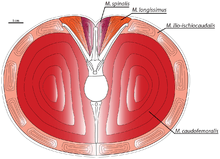
The most emblematic element from the holotype is the striking pelvis, being virtually complete; it preserves the right illium, ischium and both pubis. Although complete, the remains are slightly crushed and deformed. The illium is prominently tall measuring 51.3 cm (513 mm) in length and 28.8 cm (288 mm) in height with a preacetabular situated from top to bottom. It is full of tissue traces: in an inner side view, both m. caudofemoralis are preserved. On the anterior edge there are microstriations that likely gave form to the m. iliofemoralis in life, behind to this area, traces of the m. ilio tibialis-2 are also preserved. The pubis measures 54.8 cm (548 mm) long and is very straight having a large distal pubic boot; striking resemblance to Carnosaurs. For instance, other dromaeosaurids have a very opisthopubic pelvic configuration, Achillobator however, has a primitive, propubic configuration. The large pubic boot preserves very coarse areas on the dorsal surface, indicators for the m. pubo ischio femoralis internus ventralis attachment. Its lateral view is very flat and sculptured, having numerous microstriations that probably originated the m. pubo ischio femoralis externus. The preserved ischium is shorter than the latter elements, measuring 37.8 cm (378 mm) in length. A large ridge is formed on its shaft and expands to the anterior edge, likely forming the m. adductor femoris in life. This ridge-like structure is heavy-built compared to other dromaeosaurids. At the side and away from the main body, the surface is very rough, possibly attaching m. flexor tibialis internus-1 in life[1] as seen in other theropods and crocodiles.[16][17]
Classification

Achillobator is classified as a dromaeosaurid, a group of very bird-like, maniraptoran dinosaurs. In its original description, Achillobator was placed as a close relative of Dromaeosaurus with an ambiguous position in the family.[1] In more recent and solid research the genus is considered to be part of the Eudromaeosauria, a group of dromaeosaurids that were obligate terrestrial and hypercarnivore animals, better known as the "true dromaeosaurids".[18] They strongly differ from other dromaeosaurs, such as the arboreal microraptorians[19] or amphibious halszkaraptorines.[20]

Eudromaeosauria was first defined as a node-based clade by Nicholas R. Longrich and Philip J. Currie in 2009 as the most inclusive natural group containing Dromaeosaurus, Velociraptor, Deinonychus, and Saurornitholestes, their most recent common ancestor and all of its other descendants. The various "subfamilies" have also been re-defined as clades, usually defined as all species closer to the groups namesake than to Dromaeosaurus or any namesakes of other sub-clades.[18]
The recent phylogenetic analysis conducted by Hartman and colleagues in 2019, surprisingly recovers Achillobator as the sister taxon of Yixianosaurus,[6] not only that but Currie and Evans 2020 have recover the position of the genus within the Velociraptorinae.[7] Although some analyses have place the genus in unusual positions, Achillobator has been recovered as a dromaeosaurine very related to Utahraptor and Dromaeosaurus in most phylogenetic analyses.[21][2][22][20] Even more similarities within Achillobator and Utahraptor were found with the osteological reexamiation of Utahraptor specimens, supporting their close relationships.[23]
During the description of Halszkaraptor in 2017 and the coined Halszkaraptorinae, new affinities for dromaeosaurids were proposed in order to include this new subfamily. Achillobator was recovered in a basal position outside a clade formed by Dromaeosaurus and Utahraptor.[20] But in the results for the Eudromaeosauria phylogeny based on the phylogenetic analysis conducted by Jasinski and colleagues in 2020 during the description of Dineobellator, Achillobator was again recovered in the traditional Utahraptor+Achillobator clade but this time outside the Dromaeosaurinae.[15]
Left cladogram as in Cau et al. 2017,[20] and right cladogram in Jasinski et al. 2020:[15]
|
|
Paleobiology
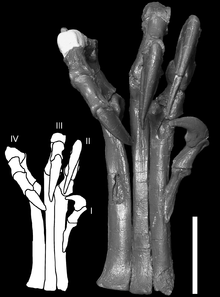
The structure of the hindlimbs and pelvic region of Achillobator indicates that the animal had massive thighs and robustly built legs suited for moderate fast-running. In addition, the prominent pelvis of Achillobator has its own specialized femoral muscle retractors that seem to indicate a strong ability for leaping.[1] However, it appears to be that dromeosaurids were not a highly cursorial group of dinosaurs. In 2016, Scott Persons IV and Currie examined the limb proportion of numerous theropods and found that compsognathids, troodontids and tyrannosauroids were cursorial animals with many taxa recovered with relatively high CLP (Cursorial-limb-proportion) scores, but dromaeosaurids being recovered with low CLP scores. Achillobator was recovered scoring −5.3, indicating that, despite having powerful legs which are more related to ambush predators, they were animals not adapted to maintain high speeds for extended amounts of time.[24]
.jpg)
Manning et al. 2009 tested the function of the "sickle claw" of dromaeosaurids by analyzing the biomechanics of how stresses and strains would be distributed along the claws and into the limbs, and using comparisons within the curvature of the dromaeosaurid "sickle claw" on the foot with curvature in modern birds and mammals. They found that they were ideal for climbing and for a ground-dwelling life style.[25] Peter Mackovicky stated that the analysis might be correct on primitive dromaeosaurids (such as Microraptor) being tree-climbers, however, this doesn't explain why giant animals like Achillobator or Utahraptor retained "sickle claws" when they were way too large to have climbed trees. Mackovicky suggested that larger dromaeosaurids adapted the claw to be used exclusively for a more aggressive predatory behaviour.[26]
The striking resemblance between the feet and legs of dromaeosaurids and those of accipitrid birds of prey, led Fowler et al. 2011 to propose that dromaeosaurids hunted in a similar way to those raptorial birds. They found that the feet and legs of dromaeosaurs resemble those of eagles and hawks by having an enlarged second claw and a similar range of flexion, but the metatarsals share more resemblance to those of owls. The model RPR (Raptor Prey Restraint), proposes that dromaeosaurs leaped into their prey, immobilizing it with their body weight, and then hold it tightly with the large, sickle-shaped claws; afterwards, the dromaeosaur would start to feed on the animal while it's still alive and the death will eventually came from blood loss and organ failure. The arms or "wings", that were likely covered in long feathers (evidenced on Zhenyuanlong[13]), may have been flapped by the dromaeosaur in order to stabilize its balance while restraining prey, along with this, the long, feathered tail probably worked as a counter-balance to the main body. Lastly, the snout would have been useful for finishing off its prey. With these observations, they established that dromaeosaurids and troodontids were niche partitioned as large and small prey predators, respectively.[27]
Paleoecology

The remains of Achillobator were unearthed from the Burkhant locality at the Bayan Shireh Formation. This formation has been divided into upper and lower parts, with some localities representing Lower and Upper Cretaceous boundary.[28][29][30][31] Burkhant, the type locality of Achillobator, has been identified as a Upper Cretaceous-boundary locality, meaning that is part of the upper Bayan Shireh.[32] Analyses on the magnetostratigraphy of the formation indicate that the entire Bayan Shireh lies within the Cretaceous Long Normal, which lasted only until the end of the Santonian stage, giving a Cenomanian-Santonian age.[33] The recent calcite U–Pb analyses performed by Kurudama and colleagues in 2020 have confirm the age of the Bayan Shireh Formation from 95.9 ± 6.0 million to 89.6 ± 4.0 million years ago, also supporting a Cenomanian-Santonian age.[34]
Over the time, a strong correlation with the Iren Dabasu Formation has been proposed by numerous authors mainly based on the similar fossil assemblages.[35][36][31] This hypothesis may be also supported by the similar ages: based on U–Pb, paleomagnetic and biostratigraphic analyses, the Iren Dabasu Formation has been dated about 95.8 ± 6.2 million years ago, very similar to Bayan Shireh.[37]
Therizinosaurs were some of the most abundant theropods in terms of biodiversity across the formation, as evidenced on the remains of Enigmosaurus, Erlikosaurus, Segnosaurus and an unnamed two-fingered therizinosaur that remains undescribed.[38][39] Hadrosauroids appear to have been pretty abundant too, with remains discovered at numerous localities of the formation, particularly at Baynshire.[40] Furthermore, the relatively new genus Gobihadros is known from at least three localities.[32][41] Most ecological niches appear to have been well established in the formation. While other dromaeosaurids filled a variety of specialized ecological niches like the slender unenlagiines, eudromaeosaurs, such as the ponderous Achillobator, retained a conservative life-style and filled the niche of large-bodied predators of often medium to large-sized prey. Achillobator may have been predators of large-sized prey.[18][9][42] Apparently, there was niche partitioning among species, such is the case of high browsers Erlikosaurus and Segnosaurus,[43] or the grazers Talarurus and browsers Tsagantegia.[44] Erketu, a genus of long necked sauropods from the formation, may have been the tallest herbivores.[9]
The re-examination of the maxillae in eudromaeosaur taxa indicates that Asian and North American eudromaeosaurs were separated by snout morphology and ecological strategies. The maxilla is apparently a reliable reference when inferring the shape of the premaxilla and overall snout. For instance, most Asian species have elongated snouts based on the maxilla (animals like Velociraptor are known from complete skulls though), indicating a selective feeding, such as picking up small, fast prey. Achillobator however, are an exception for Asian eudromaeosaurs, featuring robust and deep maxillar morphology and thus indicating a strong connection and relationships to North American members, which have stocky and deep snouts. The adaptations of Achillobator and North American eudromaeosaurs demonstrate a conservative ecology mainly based on large-sized prey.[42]
Environment and paleoflora
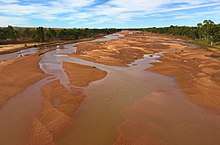
The presence of caliche, fluvial and lacustrine sedimentation at various localities indicates a semi-arid climate with large water bodies, such as rivers, lakes and streams.[45][46][35][47] The Bayan Shireh Formation was considered to be partially lacustrine by Samoilov and Benjamini in 1996,[47] however, large scale cross-stratifications on various sandstone layers at the Baynshire locality are indicators of prominent meanders, in addition to this, it is implied that the presence of large river bodies drained the eastern part of the Gobi Desert.[33] The cornaceans Bothrocaryum gobience and Nyssoidea mongolica have been reported from the Khara Khutul locality, which has also yielded the therizinosaurs Enigmosaurus and Segnosaurus. Additional findings on this locality and Bor Guvé seem to reflect the large presence of angiosperm plants across the formation, with numerous fossil fruits recovered which bear a superficial resemblance to the modern-day okra, however, the taxonomic affinities are quite unclear.[28][48]
Contemporaneous paleofauna
Paleofauna that were contemporaneous with the large dromaeosaurids in the upper Bayan Shireh (or Late Cretaceous beds), included a rich diversity of dinosaur and non-dinosaur genera. Fellow dinosaur genera included the medium-sized theropods Erlikosaurus,[43] Garudimimus,[49] Segnosaurus[43] and possibly Alectrosaurus.[50] Heavy-built ankylosaurs Talarurus and Tsagantegia.[44] Small marginocephalians Amtocephale[51] and Graciliceratops.[52] The basal hadrosauroids Gobihadros[32] and the large, long-necked sauropods Erketu.[48]

Non-dinosaur taxa was present as well, mostly compromising semiaquatic and terrestrial reptiles like the turtles Lindholmemys,[53] Gobiapalone and "Trionyx".[54] Crocodylomorphs are represented by Paralligator[55] and a reported ichnotaxon that was made by a swimming individual.[39] Fishes are also known from the formation. The primitive sharks Hybodus and the remains of osteichthyan fish at various localities are fine representatives.[31]
Several unnamed and/or undescribed taxa have been reported from localities across the formation, mostly dinosaur taxa: unnamed azhdarchid with one specimen also found at Burkhant,[56] unnamed giant caenagnathid preserving a lower jaw that is extremely similar to that of Gigantoraptor,[36] unnamed hadrosauroid (apparently smaller than Gobihadros),[41] unnamed two-fingered therizinosaur,[38] unnamed titanosaur known from the locality of Erketu[57] and an unnamed velociraptorine-grade dromaeosaurid.[58][59]
References
- Perle, A.; Norell, M. A.; Clark, J. M. (1999). "A new maniraptoran Theropod−Achillobator giganticus (Dromaeosauridae)−from the Upper Cretaceous of Burkhant, Mongolia". Contributions from the Geology and Mineralogy Chair, National Museum of Mongolia (101): 1–105. OCLC 69865262.
- Turner, A.H.; Makovicky, P.J.; Norell, M.A. (2012). "A Review of Dromaeosaurid Systematics and Paravian Phylogeny". Bulletin of the American Museum of Natural History. 2012 (371): 1–206. doi:10.1206/748.1. hdl:2246/6352.
- Senter, P. (2007). "A method for distinguishing dromaeosaurid manual unguals from pedal sickle claws" (PDF). Bulletin of Gunma Museum of Natural History (11): 1–6. ISSN 1342-4092.
- Burnham, D.A.; Derstler, K.L.; Currie, P.J.; Bakker, R.T.; Zhou, Z.; Ostrom, J.H. (2000). "Remarkable New Birdlike Dinosaur (Theropoda: Maniraptora) from the Upper Cretaceous of Montana". The University of Kansas Paleontological Contributions. 13: 1–14. doi:10.17161/PCNS.1808.3761. hdl:1808/3761. ISSN 1046-8390.
- Norell, M.A.; Makovicky, P.J. (2004). "Dromaeosauridae". In Weishampel, D.B.; Dodson, P.; Osmólska, H. (eds.). The Dinosauria (2nd ed.). University of California Press. p. 207. ISBN 9780520941434.
- Hartman, S.; Mortimer, M.; Wahl, W.R.; Lomax, D.R.; Lippincott, J.; Lovelace, D.M. (2019). "A new paravian dinosaur from the Late Jurassic of North America supports a late acquisition of avian flight". PeerJ. 7: e7247. doi:10.7717/peerj.7247. PMC 6626525. PMID 31333906.
- Currie, P. J.; Evans, D. C. (2020). "Cranial Anatomy of New Specimens of Saurornitholestes langstoni (Dinosauria, Theropoda, Dromaeosauridae) from the Dinosaur Park Formation (Campanian) of Alberta". The Anatomical Record. 303 (4): 691–715. doi:10.1002/ar.24241. PMID 31497925.
- Holtz, T. R.; Rey, L.V. (2007). Dinosaurs: The Most Complete, Up-to-Date Encyclopedia for Dinosaur Lovers of All Ages. Random House. ISBN 9780375824197.CS1 maint: date and year (link) Genus List for Holtz 2012 Weight Information
- Paul, G. S. (2016). The Princeton Field Guide to Dinosaurs (2nd ed.). Princeton, New Jersey: Princeton University Press. p. 151. ISBN 9780691167664.
- Turner, A.H.; Pol, D.; Clarke, J.A.; Erickson, G.M.; Norell, M.A. (2007). "A Basal Dromaeosaurid and Size Evolution Preceding Avian Flight". Science. 317 (5843): 1378–1381. Bibcode:2007Sci...317.1378T. doi:10.1126/science.1144066. PMID 17823350. Supporting Online Material
- Novas, F.E.; Pol, D.; Canale, J.I.; Porfiri, J.D.; Calvo, J.O. (2008). "A bizarre Cretaceous theropod dinosaur from Patagonia and the evolution of Gondwanan dromaeosaurids". Proceedings of the Royal Society B: Biological Sciences. 276 (1659): 1101–1107. doi:10.1098/rspb.2008.1554. ISSN 1471-2954. PMC 2679073. PMID 19129109.
- Turner, A.H.; Makovicky, P.J.; Norell, M.A. (2007). "Feather quill knobs in the dinosaur Velociraptor". Science. 317 (5845): 1721. Bibcode:2007Sci...317.1721T. doi:10.1126/science.1145076. PMID 17885130.
- Lü, J.; Brusatte, S.L. (2015). "A large, short-armed, winged dromaeosaurid (Dinosauria: Theropoda) from the Early Cretaceous of China and its implications for feather evolution". Scientific Reports. 11775 (5): 11775. Bibcode:2015NatSR...511775L. doi:10.1038/srep11775. PMC 4504142. PMID 26181289.
- DePalma, R.A.; Burnham, D.A.; Martin, L.D.; Larson, P.L.; Bakker, R.T. (2015). "The First Giant Raptor (Theropoda: Dromaeosauridae) from the Hell Creek Formation". Paleontological Contributions. 2015 (14): 1–16. doi:10.17161/paleo.1808.18764.
- Jasinski, S. E.; Sullivan, R. M.; Dodson, P. (2020). "New Dromaeosaurid Dinosaur (Theropoda, Dromaeosauridae) from New Mexico and Biodiversity of Dromaeosaurids at the end of the Cretaceous". Scientific Reports. 10 (1): 5105. doi:10.1038/s41598-020-61480-7. ISSN 2045-2322. PMC 7099077. PMID 32218481.
- Romer, A.S. (1923). "The pelvic musculature of saurischian dinosaurs" (PDF). Bulletin of the American Museum of Natural History. 48 (19): 605–617.
- Perle, A. (1998). "Primitive models of the pelvic and hindlimb structures-muscles of reptiles (lizards, crocodiles and birds)". Mongolian Geoscientist (9): 26−35.
- Longrich, N.R.; Currie, P.J. (2009). "A microraptorine (Dinosauria–Dromaeosauridae) from the Late Cretaceous of North America". Proceedings of the National Academy of Sciences. 106 (13): 5002–5007. Bibcode:2009PNAS..106.5002L. doi:10.1073/pnas.0811664106. PMC 2664043. PMID 19289829.
- Han, G.; Chiappe, L. M.; Ji, S.-A.; Habib, M.; Turner, A. H.; Chinsamy, A.; Liu, X.; Han, L. (2014). "A new raptorial dinosaur with exceptionally long feathering provides insights into dromaeosaurid flight performance". Nature Communications. 5 (4382): 4382. Bibcode:2014NatCo...5.4382H. doi:10.1038/ncomms5382. PMID 25025742.
- Cau, A.; Beyrand, V.; Voeten, D. F. A. E.; Fernandez, V.; Tafforeau, P.; Stein, K.; Barsbold, R.; Tsogtbaatar, K.; Currie, P. J.; Godefroit, P. (2017). "Synchrotron scanning reveals amphibious ecomorphology in a new clade of bird-like dinosaurs". Nature. 552 (7685): 395–399. Bibcode:2017Natur.552..395C. doi:10.1038/nature24679. PMID 29211712.
- Senter, P.; Barsbold, R.; Britt, B. B; Burnham, D. A. (2004). "Systematics and evolution of Dromaeosauridae (Dinosauria, Theropoda)". Bulletin of Gunma Natural History Museum. 8: 1–20.
- Senter, P.; Kirkland, J. I.; Deblieux, D. D.; Madsen, S.; Toth, N. (2012). "New Dromaeosaurids (Dinosauria: Theropoda) from the Lower Cretaceous of Utah, and the Evolution of the Dromaeosaurid Tail". PLOS ONE. 7 (5): e36790. Bibcode:2012PLoSO...736790S. doi:10.1371/journal.pone.0036790. PMC 3352940. PMID 22615813.
- Britt, B. B.; Chure, D. J.; Stadtman, K. L.; Madsen, J. H.; Scheetz, R. D.; Burge, D. L. (2001). "New osteological data and the affinities of Utahraptor from the Cedar Mountain Fm. (Early Cretaceous) of Utah". Journal of Vertebrate Paleontology. 21 (supp. 3): 36A. doi:10.1080/02724634.2001.10010852.
- Scott Persons IV, W.; Currie, P. J. (2016). "An approach to scoring cursorial limb proportions in carnivorous dinosaurs and an attempt to account for allometry". Scientific Reports. 6 (19828): 19828. Bibcode:2016NatSR...619828P. doi:10.1038/srep19828. PMC 4728391. PMID 26813782.
- Manning, P.L.; Margetts, L.; Johnson, M.R.; Withers, P.J.; Sellers, W.I.; Falkingham, P.L.; Mummery, P.M.; Barrett, P.M.; Raymont, D.R. (2009). "Biomechanics of dromaeosaurid dinosaur claws: Application of X-ray microtomography, nanoindentation, and finite element analysis". The Anatomical Record. 292 (9): 1397–1405. doi:10.1002/ar.20986. PMID 19711472.
- "Killing claws of Velociraptor… are for climbing". New Scientist. 203 (2725): 10. 2009. doi:10.1016/s0262-4079(09)62381-2.
- Fowler, D.W.; Freedman, E.A.; Scannella, J.B.; Kambic, R.E. (2011). "The Predatory Ecology of Deinonychus and the Origin of Flapping in Birds". PLOS ONE. 6 (12): e28964. Bibcode:2011PLoSO...628964F. doi:10.1371/journal.pone.0028964. PMC 3237572. PMID 22194962.
- Khand, Y.; Badamgarav, D.; Ariunchimeg, Y.; Barsbold, R. (2000). "Cretaceous system in Mongolia and its depositional environments". Cretaceous Environments of Asia. Developments in Palaeontology and Stratigraphy. 17. pp. 49–79. doi:10.1016/s0920-5446(00)80024-2. ISBN 9780444502766.
- Shuvalov, V.F. (2003). "The Cretaceous stratigraphy and palaeobiogeography of Mongolia". The Age of Dinosaurs in Russia and Mongolia. Cambrige University Press. pp. 256–278. ISBN 9780521545822.
- Eberth, D.A.; Kobayashi, Y.; Lee, Y.N.; Mateus, O.; Therrien, F.; Zelenitsky, D.K.; Norell, M.A. (2009). "Assignment of Yamaceratops dorngobiensis and associated redbeds at Shine Us Khudag (eastern Gobi, Dorngobi Province, Mongolia) to the redescribed Javkhlant Formation (Upper Cretaceous)". Journal of Vertebrate Paleontology. 29 (1): 295–302. doi:10.1080/02724634.2009.10010384.
- Averianov, A.; Sues, H. (2012). "Correlation of Late Cretaceous continental vertebrate assemblages in Middle and Central Asia" (PDF). Journal of Stratigraphy. 36 (2): 462–485.
- Tsogtbaatar, K.; Weishampel, D.B.; Evans, D.C.; Watabe, M. (2019). "A new hadrosauroid (Dinosauria: Ornithopoda) from the Late Cretaceous Baynshire Formation of the Gobi Desert (Mongolia)". PLOS ONE. 14 (4): e0208480. Bibcode:2019PLoSO..1408480T. doi:10.1371/journal.pone.0208480. PMC 6469754. PMID 30995236.
- Hicks, J.F.; Brinkman, D.L.; Nichols, D.J.; Watabe, M. (1999). "Paleomagnetic and palynologic analyses of Albian to Santonian strata at Bayn Shireh, Burkhant, and Khuren Dukh, eastern Gobi Desert, Mongolia". Cretaceous Research. 20 (6): 829–850. doi:10.1006/cres.1999.0188.
- Kurumada, Y.; Aoki, S.; Aoki, K.; Kato, D.; Saneyoshi, M.; Tsogtbaatar, K.; Windley, B. F.; Ishigaki, S. (2020). "Calcite U–Pb age of the Cretaceous vertebrate‐bearing Bayn Shire Formation in the Eastern Gobi Desert of Mongolia: usefulness of caliche for age determination". Terra Nova. doi:10.1111/ter.12456.
- Jerzykiewicz, T.; Russell, D. A. (1991). "Late Mesozoic stratigraphy and vertebrates of the Gobi Basin". Cretaceous Research. 12 (4): 345−377. doi:10.1016/0195-6671(91)90015-5.
- Tsuihiji, T.; Watabe, M.; Barsbold, R.; Tsogtbaatar, K. (2015). "A gigantic caenagnathid oviraptorosaurian (Dinosauria: Theropoda) from the Upper Cretaceous of the Gobi Desert, Mongolia". Cretaceous Research. 56: 60−65. doi:10.1016/j.cretres.2015.03.007.
- Guo, Z. X.; Shi, Y. P.; Yang, Y. T.; Jiang, S. Q.; Li, L. B.; Zhao, Z. G. (2018). "Inversion of the Erlian Basin (NE China) in the early Late Cretaceous: Implications for the collision of the Okhotomorsk Block with East Asia" (PDF). Journal of Asian Earth Sciences. 154: 49–66. Bibcode:2018JAESc.154...49G. doi:10.1016/j.jseaes.2017.12.007.
- Kobayashi, Y.; Chinzorig, T.; Tsogtbaatar, K.; Barsbold, R. (2015). "A new therizinosaur with functionally didactyl hands from the Bayanshiree Formation (Cenomanian-Turonian), Omnogovi Province, southeastern Mongolia" (PDF). Journal of Vertebrate Paleontology. Program and Abstracts. Photographs
- Lee, Y.M.; Lee, H.J.; Kobayashi, Y.; Carabajal, A.P.; Barsbold, R.; Fiorillo, A.R.; Tsogtbaatar, K. (2019). "Unusual locomotion behaviour preserved within a crocodyliform trackway from the Upper Cretaceous Bayanshiree Formation of Mongolia and its palaeobiological implications". Palaeogeography, Palaeoclimatology, Palaeoecology. 533 (109353): 2. Bibcode:2019PPP...533j9239L. doi:10.1016/j.palaeo.2019.109239.
- Ishigaki, S.; Tsogtbaatar, K.; Saneyoshi, M.; Mainbayar, B.; Aoki, K.; Ulziitseren, S.; Imayama, T.; Takahashi, A.; Toyoda, S.; Bayardorj, C.; Buyantegsh, B.; Batsukh, J.; Purevsuren, B.; Asai, H.; Tsutanaga, S.; Fujii, K. (2016). "Report of the Okayama University of Science - Mongolian Institute of Paleontology and Geology Joint Expedition in 2016" (PDF). Bulletin of Research Institute of Natural Sciences (42): 33−46.
- Slowiak, J.; Szczygielski, T.; Ginter, M.; Fostowicz-Frelik, L. (2020). "Uninterrupted growth in a non‐polar hadrosaur explains the gigantism among duck‐billed dinosaurs". Paleontology. doi:10.1111/pala.12473.
- Powers, M. A.; Sullivan, C.; Currie, P. J. (2020). "Re-examining ratio based premaxillary and maxillary characters in Eudromaeosauria (Dinosauria: Theropoda): Divergent trends in snout morphology between Asian and North American taxa". Palaeogeography, Palaeoclimatology, Palaeoecology. 547 (109704). Bibcode:2020PPP...547j9704P. doi:10.1016/j.palaeo.2020.109704.
- Zanno, L.E.; Tsogtbaatar, K.; Chinzorig, T.; Gates, T.A. (2016). "Specializations of the mandibular anatomy and dentition of Segnosaurus galbinensis (Theropoda: Therizinosauria)". PeerJ. 4: e1885. doi:10.7717/peerj.1885. PMC 4824891. PMID 27069815.
- Park, J.Y.; Lee, Y.N.; Currie, P.J.; Kobayashi, Y.; Koppelhus, E.; Barsbold, R.; Mateus, O.; Lee, S.; Kim, S.H. (2020). "Additional skulls of Talarurus plicatospineus (Dinosauria: Ankylosauridae) and implications for paleobiogeography and paleoecology of armored dinosaurs". Cretaceous Research. 108: 104340. doi:10.1016/j.cretres.2019.104340.
- Vasiliev, V.G.; Volkhonin, V.C.; Grishin, G.L.; Ivanov, A.K.; Marinov, I.A.; Mokshancev, K.B. (1959). Geological structure of the People's Republic of Mongolia (stratigraphy and tectonics). p. 492.
- Martinson, G.G. (1982). "The Upper Cretaceous mollusks of Mongolia". Sovmestnaya Sovetsko– Mongolskaya Paleontolog-icheskaya Ekspeditsia. 17: 5–76.
- Samoilov, V.S.; Benjamini, C. (1996). "Geochemical features of dinosaur remains from the Gobi Desert, South Mongolia". PALAIOS. 11 (6): 519–531. Bibcode:1996Palai..11..519S. doi:10.2307/3515188. JSTOR 3515188.
- Ksepka, D.T.; Norell, M.A. (2006). "Erketu ellisoni, a long-necked sauropod from Bor Guvé (Dornogov Aimag, Mongolia)" (PDF). American Museum Novitates. 2006 (3508): 1–16. doi:10.1206/0003-0082(2006)3508[1:EEALSF]2.0.CO;2.
- Kobayashi, Y.; Barsbold, R. (2005). "Reexamination of a primitive ornithomimosaur, Garudimimus brevipes Barsbold, 1981 (Dinosauria: Theropoda), from the Late Cretaceous of Mongolia" (PDF). Canadian Journal of Earth Sciences. 42 (9): 1501−1521. Bibcode:2005CaJES..42.1501K. doi:10.1139/e05-044. hdl:2115/14579.
- Perle, A. (1977). "O pervoy nakhodke Alektrozavra (Tyrannosauridae, Theropoda) iz pozdnego Mela Mongolii" [On the first discovery of Alectrosaurus (Tyrannosauridae, Theropoda) in the Late Cretaceous of Mongolia]. Shinzhlekh Ukhaany Akademi Geologiin Khureelen (in Russian). 3 (3): 104–113.
- Watabe, M.; Tsogtbaatar, K.; Sullivan, R.M. (2011). "A new pachycephalosaurid from the Baynshire Formation (Cenomanian-late Santonian), Gobi Desert, Mongolia" (PDF). Fossil Record 3. New Mexico Museum of Natural History and Science, Bulletin. 53: 489–497.
- Sereno, P.C. (2000). "The fossil record, systematics and evolution of pachycephalosaurs and ceratopsians from Asia" (PDF). The Age of Dinosaurs in Russia and Mongolia. Cambridge University Press. pp. 489–491.
- Sukhanov, V.B.; Danilov, I.G.; Syromyatnikova, E.V. (2008). "The Description and Phylogenetic Position of a New Nanhsiungchelyid Turtle from the Late Cretaceous of Mongolia". Acta Palaeontologica Polonica. 53 (4): 601–614. doi:10.4202/app.2008.0405.
- Danilov, I.G.; Hirayama, R.; Sukhanov, V.B.; Suzuki, S.; Watabe, M.; Vitek, N.S. (2014). "Cretaceous soft-shelled turtles (Trionychidae) of Mongolia: new diversity, records and a revision". Journal of Systematic Palaeontology. 12 (7): 799–832. doi:10.1080/14772019.2013.847870.
- Turner, A.H. (2015). "A Review of Shamosuchus and Paralligator (Crocodyliformes, Neosuchia) from the Cretaceous of Asia". PLOS ONE. 10 (2): e0118116. Bibcode:2015PLoSO..1018116T. doi:10.1371/journal.pone.0118116. PMC 4340866. PMID 25714338.
- Watabe, M.; Suzuki, D.; Tsogtbaatar, K. (2009). "The first discovery of pterosaurs from the Upper Cretaceous of Mongolia" (PDF). Acta Palaeontologica Polonica. 54 (2): 231–242. doi:10.4202/app.2006.0068.
- Ksepka, D.; Norell, M.A. (2010). "The Illusory Evidence for Asian Brachiosauridae: New Material of Erketu ellisoni and a Phylogenetic Reappraisal of Basal Titanosauriformes" (PDF). American Museum Novitates. 3700 (3700): 1–27. doi:10.1206/3700.2.
- Kubota, K.; Barsbold, R. (2007). "New dromaeosaurid (Dinosauria Theropoda) from the Upper Cretaceous Bayanshiree Formation of Mongolia". Journal of Vertebrate Paleontology. 27 (suppl. to 3): 102A. doi:10.1080/02724634.2007.10010458.
- Kubota, K. (2015). "Descriptions of Mongolian Dromaeosaurids (Dinosauria: Theropoda) and phylogeny of Dromaeosauridae". PHD Dissertation (in Japanese).
External links



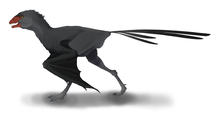
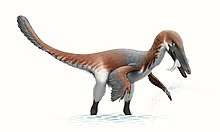
.png)
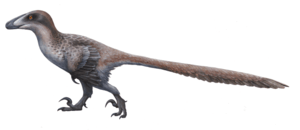

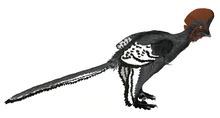
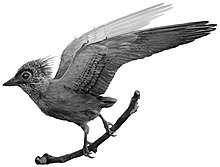

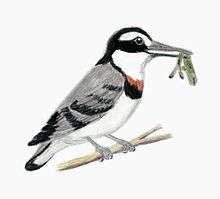
.png)
